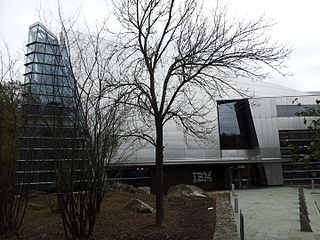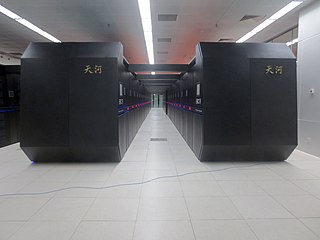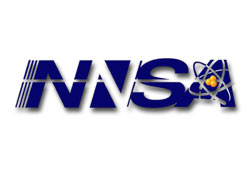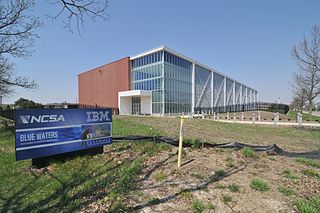 | |
| Operators | LLNL |
|---|---|
| Location | Livermore, California, United States |
| Power | 7.9 MW |
| Operating system | CNK operating system Red Hat Enterprise Linux |
| Space | 3,000 square feet (280 m2) |
| Memory | 1.5 PiB |
| Speed | 20.13 PFLOPS |
| Cost | Unknown [1] |
| Purpose | Nuclear weapons, astronomy, energy, human genome, and climate change |
IBM Sequoia is a petascale Blue Gene/Q supercomputer constructed by IBM for the National Nuclear Security Administration as part of the Advanced Simulation and Computing Program (ASC). It was delivered to the Lawrence Livermore National Laboratory (LLNL) in 2011 and was fully deployed in June 2012. [2]

In computing, petascale refers to a computer system capable of reaching performance in excess of one petaflops, i.e. one quadrillion floating point operations per second. The standard benchmark tool is LINPACK and Top500.org is the organization which tracks the fastest supercomputers. Some uniquely specialized petascale computers do not rank on the Top500 list since they cannot run LINPACK. This makes comparisons to ordinary supercomputers hard.

A supercomputer is a computer with a high level of performance compared to a general-purpose computer. The performance of a supercomputer is commonly measured in floating-point operations per second (FLOPS) instead of million instructions per second (MIPS). Since 2017, there are supercomputers which can perform up to nearly a hundred quadrillion FLOPS. Since November 2017, all of the world's fastest 500 supercomputers run Linux-based operating systems. Additional research is being conducted in China, the United States, the European Union, Taiwan and Japan to build even faster, more powerful and more technologically superior exascale supercomputers.

International Business Machines Corporation (IBM) is an American multinational information technology company headquartered in Armonk, New York, with operations in over 170 countries. The company began in 1911, founded in Endicott, New York, as the Computing-Tabulating-Recording Company (CTR) and was renamed "International Business Machines" in 1924.
Contents
- Dawn prototype
- Purpose
- Design
- Node architecture
- Job scheduler
- Filesystem
- Power usage
- Application
- See also
- References
- External links
On June 14, 2012, the TOP500 Project Committee announced that Sequoia replaced the K computer as the world's fastest supercomputer, with a LINPACK performance of 17.17 petaflops, 63% faster than the K computer's 10.51 petaflops, having 123% more cores than the K computer's 705,024 cores. Sequoia is also more energy efficient, as it consumes 7.9 MW, 37% less than the K computer's 12.6 MW. [3] [4]

The TOP500 project ranks and details the 500 most powerful non-distributed computer systems in the world. The project was started in 1993 and publishes an updated list of the supercomputers twice a year. The first of these updates always coincides with the International Supercomputing Conference in June, and the second is presented at the ACM/IEEE Supercomputing Conference in November. The project aims to provide a reliable basis for tracking and detecting trends in high-performance computing and bases rankings on HPL, a portable implementation of the high-performance LINPACK benchmark written in Fortran for distributed-memory computers.

The K computer – named for the Japanese word "kei" (京), meaning 10 quadrillion (1016) – is a supercomputer manufactured by Fujitsu, currently installed at the Riken Advanced Institute for Computational Science campus in Kobe, Hyōgo Prefecture, Japan. The K computer is based on a distributed memory architecture with over 80,000 compute nodes. It is used for a variety of applications, including climate research, disaster prevention and medical research. The K computer's operating system is based on the Linux kernel, with additional drivers designed to make use of the computer's hardware.
LINPACK is a software library for performing numerical linear algebra on digital computers. It was written in Fortran by Jack Dongarra, Jim Bunch, Cleve Moler, and Gilbert Stewart, and was intended for use on supercomputers in the 1970s and early 1980s. It has been largely superseded by LAPACK, which runs more efficiently on modern architectures.
As of November 2017 [update] , Sequoia had dropped to sixth place on the TOP500 ranking, but first to third on June 17, 2013, behind Tianhe-2 and Titan. [5] In June 2016, it slipped again, to fourth place on the TOP500 ranking. In June 2017, it slipped again, to fifth place on the TOP500 ranking. [6]

Tianhe-2 or TH-2 is a 33.86-petaflop supercomputer located in National Supercomputer Center in Guangzhou, China. It was developed by a team of 1,300 scientists and engineers.

Titan or OLCF-3 is a supercomputer built by Cray at Oak Ridge National Laboratory for use in a variety of science projects. Titan is an upgrade of Jaguar, a previous supercomputer at Oak Ridge, that uses graphics processing units (GPUs) in addition to conventional central processing units (CPUs). Titan is the first such hybrid to perform over 10 petaFLOPS. The upgrade began in October 2011, commenced stability testing in October 2012 and it became available to researchers in early 2013. The initial cost of the upgrade was US$60 million, funded primarily by the United States Department of Energy.
Record-breaking science applications have been run on Sequoia, the first to cross 10 petaflops of sustained performance. The cosmology simulation framework HACC achieved almost 14 petaflops with a 3.6 trillion particle benchmark run, [7] while the Cardioid code, [8] [9] which models the electrophysiology of the human heart, achieved nearly 12 petaflops with a near real-time simulation.
The entire supercomputer runs on Linux, with CNK running on over 98,000 nodes, and Red Hat Enterprise Linux running on 768 I/O nodes that are connected to the Lustre filesystem. [10]

Compute Node Kernel (CNK) is the node level operating system for the IBM Blue Gene series of supercomputers.

Red Hat Enterprise Linux is a Linux distribution developed by Red Hat and targeted toward the commercial market. Red Hat Enterprise Linux is released in server versions for x86-64, Power ISA, ARM64, and IBM Z, and a desktop version for x86-64. All of Red Hat's official support and training, together with the Red Hat Certification Program, focuses on the Red Hat Enterprise Linux platform. Red Hat Enterprise Linux is often abbreviated to RHEL.
Lustre is a type of parallel distributed file system, generally used for large-scale cluster computing. The name Lustre is a portmanteau word derived from Linux and cluster. Lustre file system software is available under the GNU General Public License and provides high performance file systems for computer clusters ranging in size from small workgroup clusters to large-scale, multi-site clusters.








